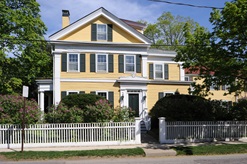Old Cambridge Historic District

Welcome to the home page for the Old Cambridge Historic District in Cambridge, Massachusetts.
Boundaries: The Old Cambridge Historic District includes most of Brattle Street, the Cambridge Common and its surroundings, Berkeley and Follen Streets, and parts of Elmwood Avenue, Craigie Street, Garden Street, and Harvard Yard. Some of the properties in this district are important to the City's pre- revolutionary past; others illustrate aspects of Cambridge's 19th and 20th century development. Click here to view a map of Cambridge's historic and neighborhood conservation districts.
Administration: The district is regulated by the Cambridge Historical Commission, a group of Cambridge citizens appointed by the City Manager. Administration of district business is provided by staff members of the Historical Commission, a department of the city government. If you have any questions about the Old Cambridge Historic District, please e-mail Sarah Burks or call the office at 617/349-4683 or TTY at 617/349-6112.
Frequently Downloaded Files:
CHC Guidelines & Policies:
General CHC Review Procedures:
Historic districts are areas in which historic buildings and their settings are protected by public review. Historic district ordinances are local laws that are adopted by communities using powers granted by the state. Historic districts comprise the city's significant historic and architectural resources. Inclusion in a historic district signifies that a property contributes to an ensemble that is worth protecting by virtue of its historic importance or architectural quality. Historic districts deserve special protection because they enhance our shared quality of life.
The Cambridge Historical Commission is empowered to regulate changes that affect the publicly-visible features of properties within a historic district. Before an applicant can undertake any work on a property in a historic district, the Commission must first issue a Certificate of Appropriateness, Hardship, or Non-Applicability. In Cambridge, all exterior changes to historic district properties are reviewed, regardless of whether a building permit is required. This includes paint and roof color, signs and structures, walls, fences, driveways, storm doors and windows, gutters, and window air conditioners. However, the Commission does not require a hearing for storm windows and storm doors that match the underlying window or door in shape, configuration, and color.
The Commission meets monthly. All projects are reviewed at public meetings, which provide an open forum for discussion. The Historical Commission considers each application individually to determine what sorts of changes are appropriate. The historic development patterns, architectural characteristics, and visual qualities of the district form the basis of the Commission's decision on what constitutes an appropriate change.
There are three types of certificates issued by the Historical Commission. A Certificate of Non-Applicability will be issued for work done in kind (work which matches existing conditions exactly), interior alterations, alterations not visible from any public way, and any other work which does not require review by the historic district commission. These certificates are generally issued by the Historical Commission staff on-the-spot. A Certificate of Appropriateness will be issued for reviewable alterations which the historic district commission deems not incongruous to the character of the property in question. Occasionally, a Certificate of Hardship will be granted for work which is not otherwise appropriate if the Commission determines that failure to approve an application would entail a substantial hardship, financial or otherwise, and that the work would not be a significant detriment to the district. One of these certificates is always necessary to obtain a building permit for work in a historic district.
All of the Commission's regulatory approvals have a life of six months. This means that the owner of the property has six months, from the date a certificate is issued, to obtain a building permit. Upon written request, the chair of the Commission may issue a six-month extension. If an extension is not issued, the owner must resubmit the Application for Certificate for the Commission's review.